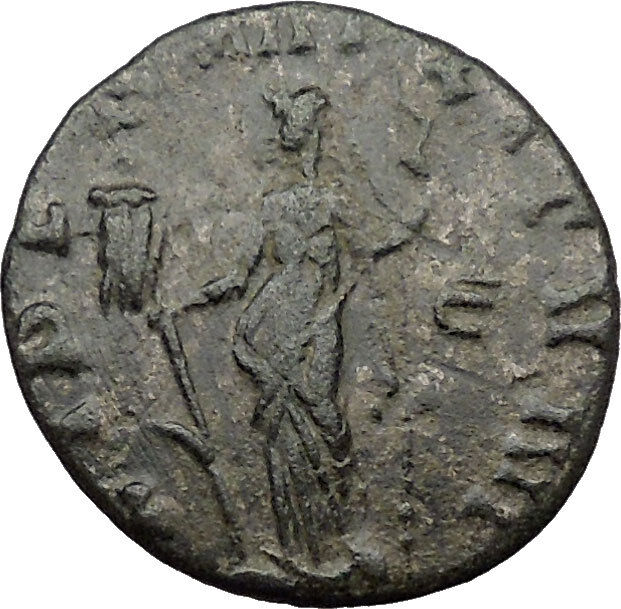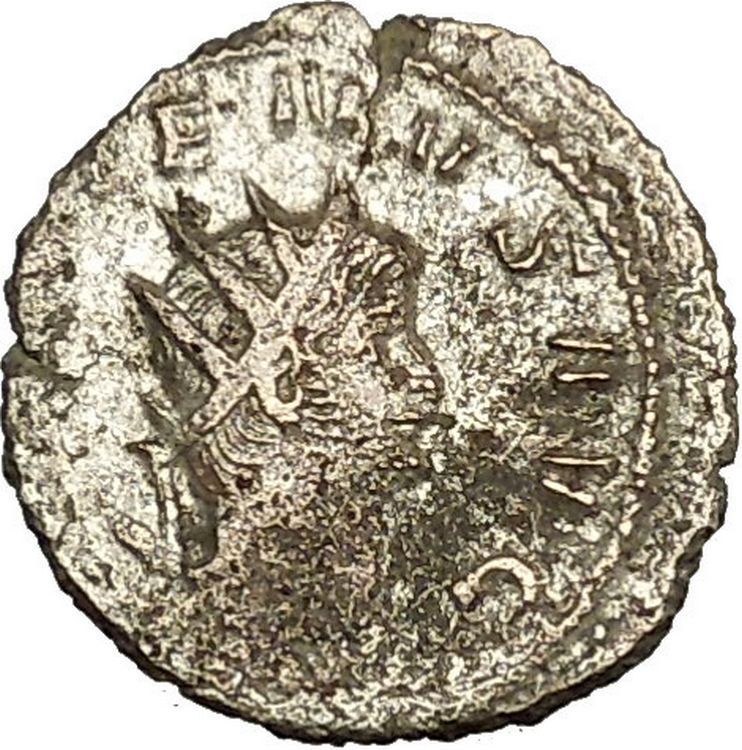|
Otacilia Severa – Roman Empress: 244-249 A.D wife of Emperor
Philip I –
Bronze Sestertius 28mm (21.48 grams) Rome mint 247-249 A.D.
Reference: RIC 208c; Cohen 48.
MARCIA OTACIL SEVERA AVG, diademed and draped bust right on crescent
PIETAS AVGVSTAE, S-C, Pietas, veiled, standing left, holding box of
incense
and raising right hand.
You are bidding on the exact
item pictured, provided with a Certificate of Authenticity and Lifetime
Guarantee of Authenticity.
Pietas, translated variously as “duty”, “religiosity” or
“religious behavior”,”loyalty”,”devotion”, or “filial
piety” (English “piety” derives from the Latin), was one of the chief
virtues
among the
ancient Romans
. It was the distinguishing
virtue of the
founding
hero
Aeneas
, who is often given the
adjectival
epithet pius throughout
Vergil
‘s epic
Aeneid
. The sacred nature of pietas
was embodied by the divine personification Pietas, a goddess often pictured on
Roman coins. The Greek equivalent is
eusebeia
.
Cicero
defined pietas as the virtue
“which admonishes us to do our duty to our country or our parents or other blood
relations.” The man who possessed pietas “performed all his duties
towards the deity and his fellow human beings fully and in every respect,” as
the 19th-century classical scholar
Georg Wissowa
described it.

Livia
wife of Augustus as Pietas
As virtue
Pietas erga parentes (“pietas toward one’s parents”) was one of
the most important aspects of demonstrating virtue. Pius as a
cognomen
originated as way to mark a person
as especially “pious” in this sense: announcing one’s personal pietas
through official nomenclature seems to have been an innovation of the
late Republic
, when
Quintus Caecilius Metellus Pius
claimed it for
his efforts to have his father,
Numidicus
, recalled from exile.
Pietas extended also toward “parents” in the sense of
“ancestors,” and was one of the basic principles of
Roman tradition
, as expressed by the care of
the dead.
Pietas as a virtue resided within a person, in contrast
to a virtue or gift such as
Victoria
, which was given by the gods.
Pietas, however, allowed a person to recognize the divine source of benefits
conferred.
The first recorded use of pietas in English occurs in Anselm Bayly’s
The Alliance of Music, Poetry, and Oratory, published in 1789.
Iconography

Denarius of Herennius, depicting Pietas and an act of pietas.
Pietas was represented on coin by cult objects, but also as a woman
conducting a sacrifice by means of fire at an altar. In the imagery of
sacrifice, libation
was the fundamental act that came to
symbolize pietas.
Pietas is first represented on Roman coins on
denarii
issued by
Marcus Herennius
in 108 or 107 BC. Pietas
appears on the obverse as a divine personification, in
bust
form; the quality of pietas is
represented by a son carrying his father on his back.Pietas is among the virtues
that appear frequently on Imperial coins, including those issued under
Hadrian
.
One of the symbols of pietas was the stork, described by
Petronius
as pietaticultrix, “cultivator
of pietas.” The stork represented filial piety in particular, as the
Romans believed that it demonstrated family loyalty by returning to the same
nest every year, and that it took care of its parents in old age. As such, a
stork appears next to Pietas on
a coin issued by Metellus Pius
(on whose
cognomen see above
).
As goddess

Flavia Maximiana Theodora
on the
obverse, on the reverse Pietas holding infant to her breast.
Pietas was the divine presence in everyday life that cautioned humans not to
intrude on the realm of the gods. Violations of pietas required a
piaculum
, expiatory rites.
A temple to Pietas was vowed (votum)
by
Manius Acilius Glabrio
at the
Battle of Thermopylae in 191 BC
.
According to a miraculous legend (miraculum),
a poor woman who was starving in prison was saved when her daughter gave her
breast milk (compare
Roman Charity
). Caught in the act, the daughter
was not punished, but recognized for her pietasas. Mother and daughter
were set free, and given public support for the rest of their lives. The site
was regarded as sacred to the goddess Pietas (consecratus deae)pietas
erga parentes
Imperial
women portrayed as Pietass
Marcia Otacilia Severa or Otacilia Severa was the Empress of
Rome and wife of
Emperor
Marcus Julius Philippus or
Philip the Arab
who reigned over the
Roman
Empire
from 244 to 249.
Severa was a member of the ancient
gens
Otacilius
who were people of consular and senatorial rank. Severa’s father was Otacilius
Severus or Severianus, who served as Roman Governor of
Macedonia
and Moesia
, while her mother was a member of gens
Marcius
or
was related to the gens. According to sources she had a brother called
Severianus, who served as Roman Governor of Lower
Moesia
between
246-247.
Little is known on her life before marrying Philip. In 234, Severa married
Philip who served in the
Praetorian Guard
under Emperor
Alexander Severus
. Severa had two children with Philip: a son named Marcus
Julius Philippus Severus or
Philippus II
(born in 238) and – according to numismatic evidence – a
daughter called Julia Severa or Severina, who is never mentioned by the ancient
Roman sources.
In February 244,
Gordian
III
was killed in Mesopotamia. There is a possibility that Severa was
involved in a conspiracy to murder Gordian. Philip became the new emperor who
gave his young predecessor a proper funeral and his ashes were returned to
Rome for burial.
Philip gave Severa the honorific title of Augusta. Their son was made
heir of the purple. Sometimes Severa and Philip are considered as the first
Christian imperial couple, because during their reign the persecutions of
Christians had ceased and the couple had become tolerant towards the faith of
the Christians. Through her intervention, she saved Bishop and Saint
Babylas of Antioch
from persecution.
In August 249, Philip had died in battle in Verona and
Decius (emperor)
became the new emperor. Severa was in Rome that time. When
the news of Philip’s death had reached Rome, Severa’s son was murdered by the
Praetorian Guard
. The child died in her arms. Severa survived her husband
and son and lived later in obscurity. Her later life is unknown.
|











